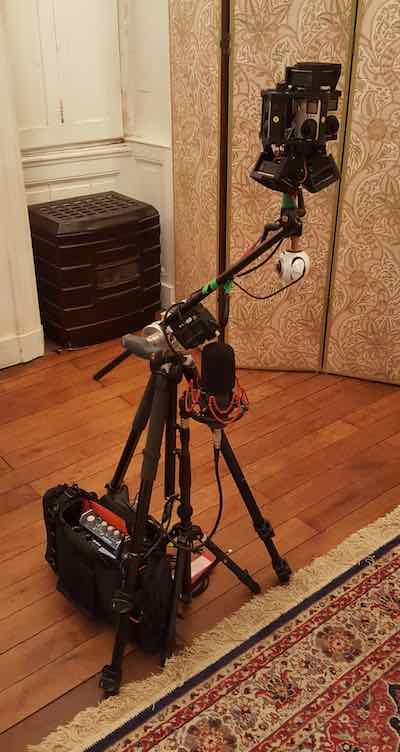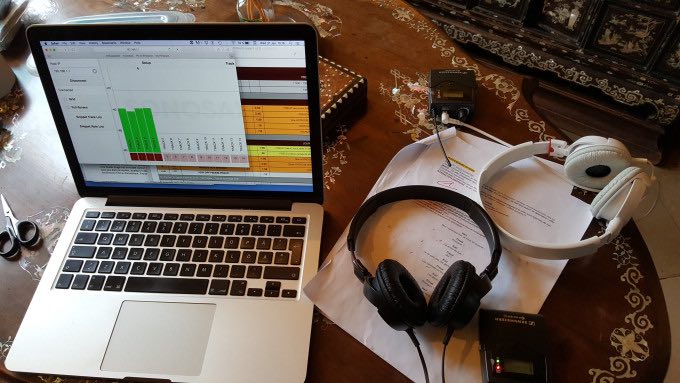The 360 video sequences were shot over three days in a small private château in Nantes, France. The actors were alone in one of the rooms decorated to match the film's narrative, and the crew were behind the wall in an adjacent room.

The camera rig was a custom-built array of eight GoPros built and operated by DVgroup. An additional small Samsung Gear 360 camera was used to provide real-time monitoring for the director.
As no cables, mics or crew members were allowed to be visible in any direction (except below the camera, an area that was re-filmed after each camera position to mask the tripod and other camera equipment), booming the actors was not considered as an option. Therefore the dialogue was recorded only with wireless lavalier mics. And maybe not so surprisingly there were a lot of problems with clothing noise. But otherwise the dialogue came through nice and clean for the most part. The production sound mixer Martin Gracineau used Wisycom transmitters and receivers, Sanken COS-11D capsules, and Sound Devices 633 recorder.
After each scene Martin recorder wild foleys with a "real" microphone (Schoeps CMC 6 with MK41 supercardioid capsule). Schoeps was also used for some off-screen dialogue tracks as well as one special effects scene where only a small portion of the 360 camera image was to be used, and thus the mic boom and the rest of the crew didn't ruin the shot.

My task was to record the scenes in ambisonics using a SoundField ST450 MKII microphone. Original idea was to use ambisonics only for two audio-only scenes. In these prologue and epilogue sequences Freud walks around the spectator in darkness while having his monologue. The boom mic would capture the voice, and the ambisonic mic would capture the spatial ambience. However, as we had the SoundField mic at our disposal we decided to try it for all the scenes just in case. Hence for each shot I carefully rigged the mic and audio bag under the GoPro array in the limited space between battery packs, cables and the Samsung camera.
Quite surprisingly the ambisonic material turned out to be useful providing nice perspective and feeling of space with authentic room reverberations. Without the close-mics the ambisonic material alone would have been almost useless; spatialisation is very blurry and in most of the camera positions the distance to the actors was too big.
Even though editing the ambisonic tracks in addition to the normal dialogue tracks and rotating them to match the picture azimuth gave some extra work, I would prefer this approach over trying to reproduce the same with plugins.

The four ambisonic B-format channels from the ST450 control unit were recorder into a Sonosax SX-R4+. It has a built-in WiFi for remote control and metering using a web browser on a computer or cellphone. That turned out to be very useful as we had to be in another room, and running in and out of the set between takes would have been unpractical. However, the wireless connection was extremely unreliable through the wall, and for one or two scenes I was forced to operate the recorder manually. Also there was no way to monitor the audio over the WiFi, so I had to "instrument fly" and let the recorder roll without listening. A wireless IEM (In-Ear Monitor) system would have solved the problem, but we didn't have an extra set available. However, as the mic was stationary all the time and I had set the gains quite conservatively (by the way, the Sonosax does not have limiters) there was not much to monitor.
After the shooting was finished it was decided that there was no time to record the prologue and epilogue, so those recordings were to be done later.
Photos: author and Jéròme Fihey
Next:
Previous: